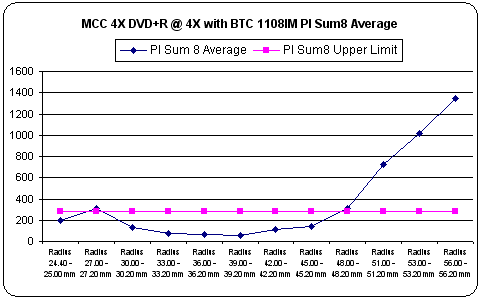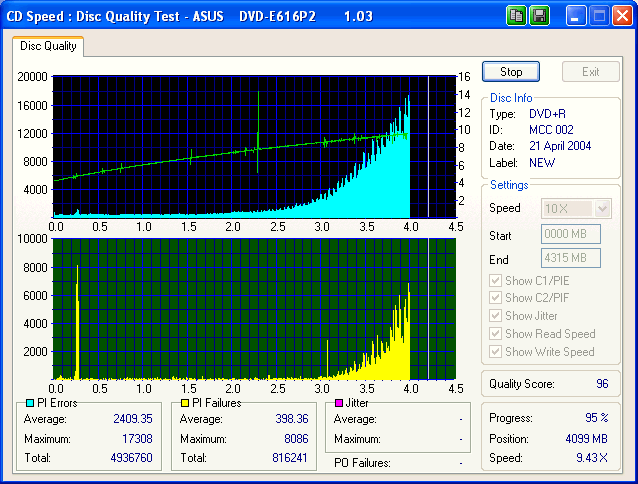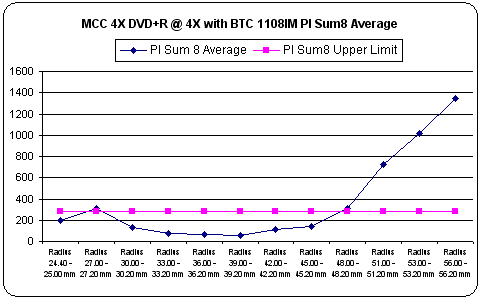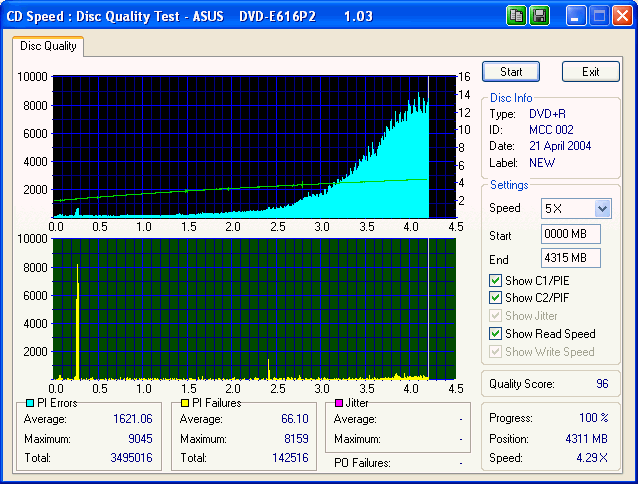Muchin,
thank you for your comments. Here are my thoughts on the issue.
quote:
1. Of course it would be better if the chipset returned errors per ECC block, but 64 ECC sum may not be that bad, IMHO.
The loss with bigger than >1ECC sampling size are:
- loss of true minima and maxima (they become rounded-off estimates)
- The above also leads to a more smooth graph overall (removing spikes)
- Inability to check for reading of the disc to be within DVD speficiation (<=4 PIF/1ECC)
Granted, those are not neseccarily big losses in overall compatibility scanning.
quote:
2. I have been searching for readers suitable for testing disc compatibility. As a working hypothesis I entertain the possibility that a picky reader is a good candidate, and such a drive must be incapable of reading low quality discs at high speeds.
Welcome onboard!
I've been trying to find a suitable test method for cd- and dvd-/+r scanning as well (for the past three years).
I've also entertained the idea of finding a one 'picky' reader.
However, here's where the problem starts.
1) There is not just one way to make an 'incompatible' disc or a 'picky' reader. A disc may be readable in drive A, not in B. With another disc the roles are reversed. There is NO 'universal picky' reader that I've been able to find. This is due to way the dvd reading is left to the implementation of the drive more than that of cd reading. There are more than one way to read a dvd disc 'correctly', leading to different compatibilities and incompatibilities.
2) Finding a picky reader that will also read discs at high speed is a bit of an oxymoron. If it is picky, it will by definition have problems in reading. If it does it at high speed, it will by definition be a very good reader (it has no problems even at high speed, when jitter in increased).
3) Picky reader, error correction capability and error reporting capability are all three different things. A reader may be excellent in tracking optical problems (i.e. 'a good reader'), but lousy at doing error correction (i.e. 'bad error correction circuitry strategy'). It may also independent of the two previous properties be able to report errors it sees in reading semi-accurately, really misleadingly or not at all.
quote:
I am sure that you are aware that Pioneer DVD-ROMs have been known to be picky.
Yes, Toshiba and Hitachi drives are also known to be picky. I've tried them and can confirm that.
However, they do fail on different types of discs. That is, they confirm, that 'pickyness' is a not a uniform characteristic of the drive.
quote:
3. Considering that ASUS drive sums 64 ECC while CATS sums 8ECC/1ECC at 1X, the PI/PIF errors at 5X are not too high except for a PIF peak.
We don't really know what CD speed reports.
This has been asked from Erik, but no straight answer has been gotten yet.
Does it report the basic sampling size error counts without calculation? Apparently not, because Erik has started 'calibrating' results across various drive models.
However, do they all report 8ECC floating window SUM for PIE and 1ECC PIF - or statistical averages of those?
Apparently not, because there are no units on the graphs and Erik hasn't replied on this issue either :)
So, for all we know, the error rates can be quite varied and not using same units.
quote:
As to this peak, it is possible that the true peak point may have been missed in the CATS scan, because there are too few data points. Another possibility is that the corresponding peak in PI errors may have been reported by the ASUS drive as PIF.
There's an important misunderstanding in that assumption.
Errors are the results of the reading. They are not on the disc.
A more likely reason that the CATS does not have the error spike, is that because it doesn't generate the error when reading.
Remember, errors are not on the disc. One cannot expect results between drives to be similar, because the drives influence how many errors are produced in the reading process.
quote:
Moreover, Erik has just revealed that the unit of measurement adopted by Nero CD-DVD Speed is byte rather than frame, the latter has been assumed to be the unit by many. Does CATS uses byte, frame or row?
Just to make sure we haven't misunderstood: I think Erik has stated that E616P2 drive reports not PIF (or even PO), but erroneous bytes in PO columns (summed for 64 ECC blocks).
Erik has not stated that the unit of measurement for error rates on DVD discs within CD Speed is bytes.
It's just that one drive that is known to report each erroneous byte in a PO row.
For instance, Mediatek chipsets do report PI/PIF per each scan command at sample size of 1ECC. So they report PIE SUM1 and PIF SUM1 at the interval at which the 'get error rates' command is issued.
quote:
4. Have you read a recent post by Erik about incorporating calibrations of a number of drives into CD-DVD Speed 3.40 and higher so that scanning the same disc with different drives will give essentially the same score even when the PIF averages differ by >2000-fold. Have you performed tests with the newest version again to see if you get the same score for this disc using different readers?
I have read it.
To put it shortly: I think the motives are pure and the goal is lofty, but overall I think it is folly.
Why?
Drives will see different amounts of errors in reading of a disc. Some drives are good at reading certain types of discs, other drives other types of discs.
There is NO WAY that both drive types can report the same error rates for the two different types of discs.
Yes, it is possible to somewhat correct for these differences, but it makes no sense, imho.
The point is to show how many errors did a drive see in the reading, while letting the characteristics of the drive show through in the error rates.
But showing somewhat 'universal' quality score is impossible, because there is no known universal one correct way to read a dvd disc (and as such, to measure it for errors in reading).
Also, basing this calculation on PIF is also false, imho. NIST has already shown with their testing that the crucial indicator of disc compatibility is it's reading error rates being below 280 PIE (in a CATS scanner).
So, there are two problems.
1) Disc quality score is not _disc_ quality. It is _disc compatibility in the drive doing the testing_. Errors are not on the disc.
2) PIF Is not the only or not even necessarily the best indicator of disc compatibility. PIE should be included as well. It could even be the determining factor, because it is a lower level error rate, not taking into account the PI row error correction strategy of the drive (which PIF/PO do).
That's all for now. I hope I didn't bore you.
As a final note, I have great respect for Erik. He's doing something I don't know how to do.
Still, that doesn't stop me from disagreeing with some of his assumptions, when I see them being clearly in opposition to the best scientific data I've been able to find on the issue.
Of course, I'm fallible myself too, so I can be wrong as well. I don't want a flame war, just a bigger understanding of the issues involved.

 Printable Version
Printable Version




















 New Messages
New Messages No New Messages
No New Messages Hot Topic w/ New Messages
Hot Topic w/ New Messages Hot Topic w/o New Messages
Hot Topic w/o New Messages Locked w/ New Messages
Locked w/ New Messages Locked w/o New Messages
Locked w/o New Messages Post New Thread
Post New Thread